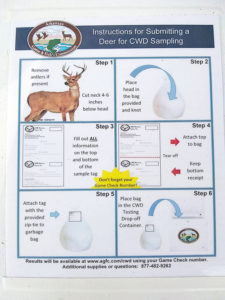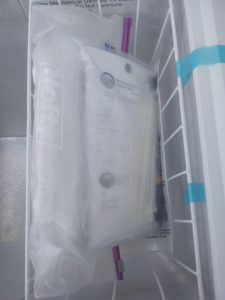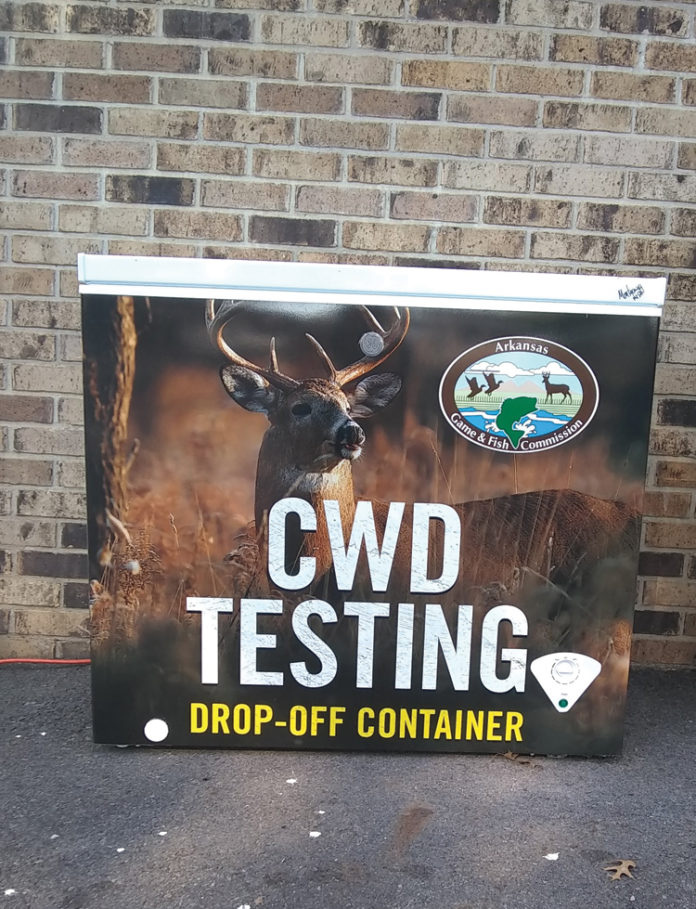(October 4, 2019) MOUNT IDA – Hunter participation in the Arkansas Game and Fish Commission’s attempts to track chronic wasting disease (CWD) is now easier in Montgomery County with the installation of a CWD collection center at the county courthouse in Mount Ida.
The collection center is Mount Ida is one of 71 collection centers currently in use in Arkansas.
While there have been no confirmed cases of CWD in deer in Montgomery County, the collection center provides a safe, discreet way for hunters and land owners to submit carcasses for testing in suspected deer.
The receptacle is located on the east side of the Montgomery County Courthouse. It can be accessed by anyone. There are instructions on the receptacle on how to prepare and submit the carcass for testing. Bags, tags and any other supplies needed can be found in the receptacle.
Once a carcass is submitted for testing it can take as little as two weeks to get a result, although it may take longer.
A full list of statewide collection sites can be found at agfc.com/cwd.
Chronic wasting disease was first discovered in Arkansas in February 2016. Later testing, determined that the disease has likely been in the state for decades before being detected. Since the first detections, AGFC has sampled and tested over 19,000 deer and elk from around the state.
There has been one confirmed case of CWD in neighboring Scott County. Other counties with confirmed cases of CWD include: Benton, Boone, Carroll, Johnson, Madison, Marion, Newton, Pope, Searcy, Sebastian, and Washington. Newton County has had the most confirmed cases by far with 369.
Chronic wasting disease is a fatal neurological disease that affects members of the deer/elk family known as cervids. It was first described in 1967 in Colorado and since has spread to 26 states, Canada, South Korea, Finland and Norway. CWD is similar to scrapie in sheep/goats and “mad cow disease” in cattle. These diseases are caused by misshapen proteins called prions, which accumulate in the tissues of affected animals, especially the brain, spinal cord, and lymph nodes. CWD is a slowly progressing disease. Infected animals will not show signs of disease for a long period of time, but late in the disease process, they will be thin and may demonstrate weakness, abnormal behavior, excessive thirst, or drooling. Animals generally die soon after the onset of these signs.

Currently it is unlawful to import, transport, or possess any portion of any species of deer, elk, moose or caribou harvested outside of the state within Arkansas, except the following low-risk items:
Antlers and cleaned skulls
Meat with all bones removed
Cleaned teeth
Hides
Finished taxidermy products
It is unlawful to possess any deer or elk harvested within the CWD Management Zone to any location in the state outside the management zone, except the low-risk items listed above.
It is unlawful to possess any deer or elk harvested within Tier 1 of the CWD Management Zone (red) in Tier 2 (orange), except the low-risk materials listed above. A map of the zones can be found at agfc.com/cwd.
It is unlawful to rehabilitate deer.
It is unlawful to use natural scents or lures that contain natural deer and elk urine or other biofluids.
Within the CWD Management Zone, button bucks do not count toward a hunter’s two-buck seasonal bag limit.
Within the CWD Management Zone, any buck may be legally harvested; All antler-point/size restrictions have been removed.
Within the CWD Management Zone, the seasonal bag limit has been increased.
Landowners within the CWD Management Zone may apply for additional deer tags to harvest bonus deer. These deer must be submitted for CWD testing. Landowners should contact their local private lands biologist to receive these tags.
It is unlawful to feed wildlife within the CWD Management Zone, except:
Bait may be used to hunt deer and elk on private land from Sept. 1-Dec. 31.
Food plots may be used year-round.

Baiting bears on private land is allowed 30 days before bear season opens. However, before Sept. 1, bears may only be baited with dog food, cat food, pastries/bread, cooking oils/grease, non-wildlife meat scraps, popped popcorn, fish and fish by-products.
Trapping furbearers with the use of bait during open furbearer trapping seasons or hunting furbearers during open furbearers hunting seasons on private land.
Incidental feeding of wildlife from active livestock operations is allowed.
Normal agricultural, gardening or soil stabilization practices are allowed.
Attracting or feeding birds and squirrels with common bird and squirrel feeders, bird baths and grain completely submerged in water is allowed.
Baiting is allowed for management, research or nuisance wildlife control only with approval by the AGFC Chief of Wildlife Management.
The Arkansas Game and Fish Commission has an entire section on their website dedicated to chronic wasting disease in Arkansas. It offers a wealth of information for those concerned with the disease.
Currently there is no evidence that CWD has been transmitted to humans, or any other species.
For more information visit agfc.com/cwd.
Article Written by Dewayne Holloway










